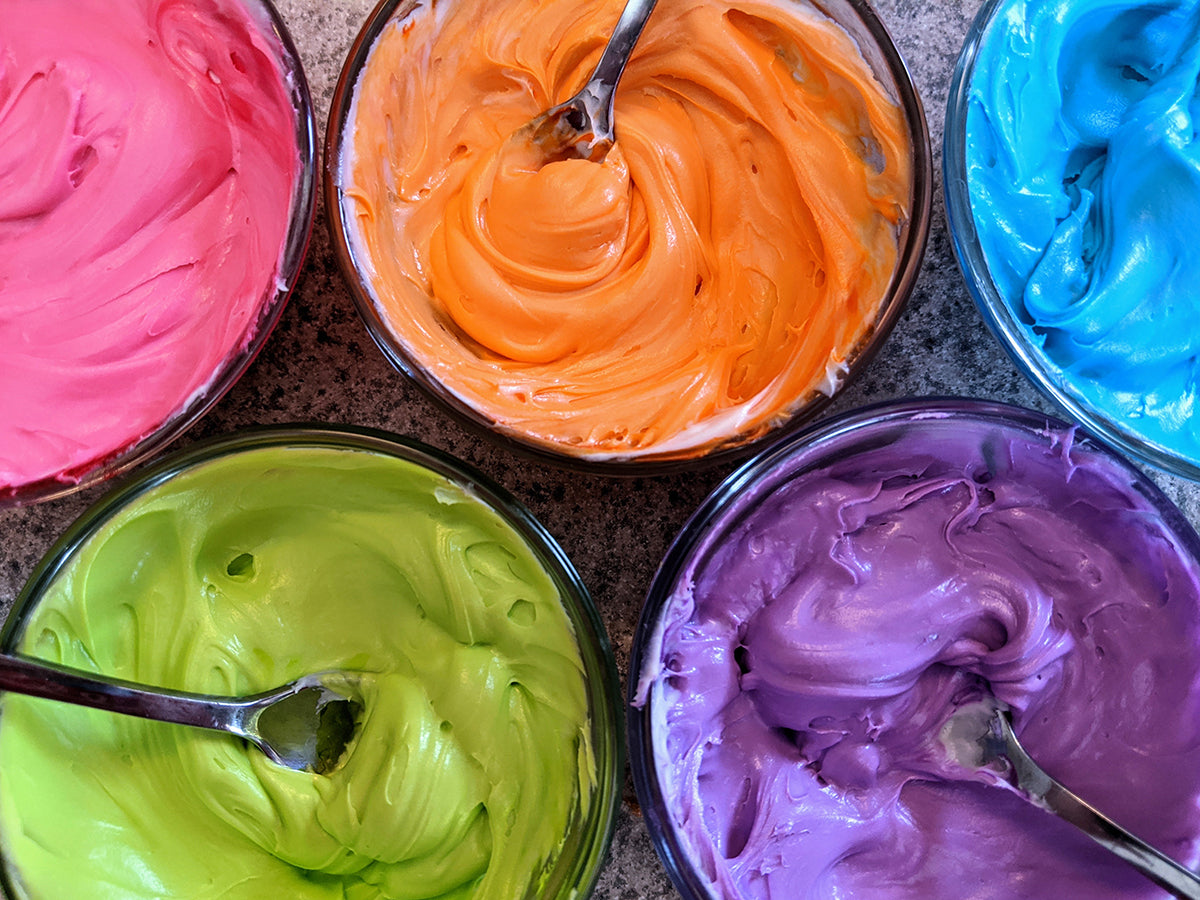COLORING BUTTERCREAM, ROLLED FONDANT, AND ROYAL ICING

When you take the right approach to color Rolled Fondant, Buttercream, and Royal Icing with Chefmaster food colorings, your baked creations turn out bright and vibrant for everyone to enjoy. Use this guide to learn the basic coloring techniques to best harness the power of liquid gel food coloring to reach your baking and decorating goals. The techniques described below can also be used with Chefmaster Natural Liqua-Gel® food colorings.

Coloring Rolled Fondant
Rolled fondant is often used to cover cakes or create decorative accents such as flowers and figurines.
Although you can color fondant by spraying it with an airbrush or an edible color spray after sculpting or shaping, it is best to color the fondant itself before starting decorating. We recommend using our concentrated Chefmaster Liqua-Gel® food coloring to tint fondant. It is important to use a good quality fondant so that you do not experience cracks or difficulties when kneading your dough.
- To prevent any difference in shade you will need to tint all the fondant you need in the same color at the same time. Therefore, make sure to calculate how much fondant you need for each color ahead of time.
- We recommend wearing disposable gloves when coloring rolled fondant to avoid having food color staining your hands and using a large silicone mat on your work surface.
- Shape your desired quantity of fondant into a ball and start kneading your fondant to soften it. Coating your hands or gloves with a light layer of shortening might help with any stickiness.
- Once the fondant is soft and pliable flatten it slightly with your hands and add a few drops of Chefmaster Liqua-Gel® food coloring of your choice to the center of your patty.
- Fold fondant over food coloring and continue kneading until the color is evenly distributed.
- Repeat as necessary with the same food coloring (or with another food coloring for custom shade) until you reach your desired shade and intensity.
- Form a ball with your fondant, tightly wrap in plastic film and set aside.
- Clean-up your hands and silicone mat (or work surface).
- Repeat the steps above for each different color of fondant you will need.
- Colored fondant can be kept for a couple of weeks in an airtight container.

Coloring Buttercream Icing
Buttercream is an extremely popular icing used to cover cakes by cake decorators. It remains soft when dry and melt in your mouth. There are many different types of Buttercream icing, some with a very high ratio of real butter and many using various ratios or butter and shortening or only shortening. As a result, not all Buttercream icings have the same base color and fat content to start with, which will affect how they react to food coloring. Chefmaster Liqua-Gel® food colorings are a great option for most Buttercream icings. On rare occasion you might need to switch to using Chefmaster Candy Color food colorings if your Buttercream icing recipe as a very high fat content. Indeed, our Candy Colors were specially formulated to be used in bases with a high fat content such as coating chocolate and certain Buttercream icings. Here are some tips to color your Buttercream icing:
- To prevent any difference in shade you will need to tint all the icing you need in the same color at the same time. Therefore, make sure to calculate how much icing you need for each color ahead of time and separate your icing in as many bowls as you need colors.
- Use a different bowl and a different rubber spatula for each color of icing you want to mix to avoid cross contamination of colors.
- Optional: If your Buttercream icing has a natural yellow color to start with (very common in recipes using 100% real butter), you can neutralize the base color by either (1) adding a very small drop of Chefmaster food coloring in Purple (Purple & Yellow being on the opposite end of the Color Spectrum) or (2) add a few drops of Chefmaster Whitener or Bright White. If you decide to use Purple to counterbalance the yellow hues, we recommend testing it on a small amount of icing first as depending on your recipe you might need a very small amount (use a toothpick dipped in food coloring instead of the bottle dropper if needed)
- Add a few drops of the Chefmaster food coloring of your choice into your bowl of Buttercream icing.
- Use a rubber spatula and a light touch when mixing your food coloring. It is better to fold the icing than to stir it to avoid affecting the its texture.
- Chefmaster food coloring are precisely formulated to blend easily and evenly with your icing and will never thin or otherwise impact its texture and taste.
- You can use our Color Mixing Guide for inspiration on how you can mix colors together to create custom hues. When experimenting with custom colors always add one color at the time and fold your icing so you can adjust as needed.
- Most colors grow deeper with time if you let them sit for a couple of hours (or 24 hours for deep colors like Red, Black and Navy).
- For darker rich colors and to avoid the bitter taste of oversaturating your icing with food coloring, we recommend starting with a chocolate buttercream icing and giving you ample time to let the colors get dipper by preparing your icing 1 or 2 days ahead of the time you are planning to decorate.
- If you are not using your icing right away cover your bowl tightly with plastic wrap making sure the film is resting directly against the icing without any air in between and refrigerate (or transfer into decorating pastry bags and refrigerate).

Coloring Royal Icing
Royal Icing is preferred to decorate cookies that are going to be individually packaged or to build and decorate Gingerbread Houses. Royal Icing dries hard and it crunchy to the bite. Some Royal Icing recipes call for fresh Egg Whites, but to prolong the shelf-life of your cookies and avoid any potential salmonella issues we recommend using a recipe calling for Meringue Powder such as Chefmaster Meringue Powder. Using a high quality Meringue Powder where Eggs and not Corn Starch is the primary ingredient will help prevent color bleeding, craters and cracks in your decorated cookies.
- To prevent any difference in shade you will need to tint all the icing you need in the same color at the same time. Therefore, make sure to calculate how much icing you need for each color ahead of time and separate your icing in as many bowls as you need colors.
- Use a different bowl and a different rubber spatula for each color of icing you want to mix to avoid cross contamination of colors.
- Add a few drops of the Chefmaster food coloring of your choice into your bowl of Royal Icing.
- Use a rubber spatula and a light touch when mixing your food coloring. It is better to fold the icing than to stir it to avoid affecting the its texture.
- Chefmaster food coloring are precisely formulated to blend easily and evenly with your icing and will never thin or otherwise impact its texture and taste.
- You can use our Color Mixing Guide for inspiration on how you can mix colors together to create custom hues. When experimenting with custom colors always add one color at the time and fold your icing so you can adjust as needed.
- Most colors grow deeper with time if you let them sit for a couple of hours (or 24 hours for deep colors like Red, Black and Navy).
- For darker rich colors and to avoid the bitter taste of oversaturating your icing with food coloring, we recommend adding a few drops of Chefmaster Buckeye Brown Liqua-Gel® first and let it sit for a couple of hours before starting coloring your icing. Give yourself enough time to let the colors grow darker and deeper by preparing your icing 1 or 2 days ahead of the time you are planning to decorate.
- If you are not using your icing right away cover your bowl tightly with plastic wrap making sure the film is resting directly against the icing without any air in between (or transfer into decorating pastry bags). Royal Icing made with fresh eggs need to be refrigerate until use, but royal icing made with meringue powder can remain on your countertop.
- You can also freeze your royal icing in tipless decorating bags until ready to use. Make sure to remove your Royal icing from the refrigerator or the freezer ahead of time to let it slowly come back to room temperature before decorating.

